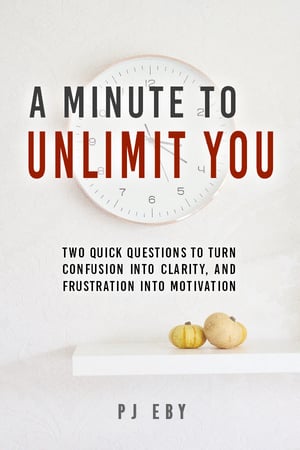When I was young, my mother used to say that however things were at midnight on New Year’s Eve, that was how they would be for the rest of the year. And so, she would push us all to clean up, tidy up ourselves and the house before that magic stroke of midnight.
Of course, it never really worked, because there is no special magic in the moment when a goal is achieved or even set. The only grain of truth in my mother’s midnight madness is this: how you do anything is how you do everything. Therefore, the life you’re living at midnight on New Year’s Eve is likely the same life that you’ll be living the rest of the year. In my mother’s case – and all too often in mine – that means being in the midst of some cycle between letting things go and going all out to bring them back in line.
So, yes, how things are on New Year’s Eve is how they’ll be all year, unless you actually change something. As I’ve suggested in previous articles, however, most behaviors are not changed by simple decisions, and not all decisions are created equal. A resolution to change a damaging behavior for the sake of a positive benefit is the most shallow kind of decision and the quickest to collapse in the face of pressure.
Tonight, though, I don’t want to get into a bunch of stuff about the decision parts of change. I’ve written a lot about that already, and still have more to write in the future. What I particularly want to write about tonight, before the magic hour, is this simple but radical truth: life is every moment.
In “The Island Within”, I wrote about the old saw that it’s “the journey, not the destination.” I’ve never really liked that saying, as I’m not somebody who especially likes journeys. Frankly, I can’t wait till we have practical teleportation! So I’ve been trying to come up with a better way to express my new understanding about the nature and quality of life, and so here is my working hypothesis.
Life is every moment. There is no future moment at which we will be fulfilled. Every setback and every victory is just one moment. Imagination and memory allow you to “copy” those moments into other moments, but the moment itself stands alone. The thoughts I play back or project in this moment determine my experience now, in this moment, and my entire life is an ongoing series of such moments.
In this way, I literally create my entire life from my habits of thought and behavior. In the absence of changes to the contrary, I will continue to play out the same dramas over and over again in my life – and how many people do you know who are doing the same?
In this moment, I feel frustrated because I don’t know how to say what I really mean. It’s like waking up and realizing, ohmygod, I’m actually running this crazy show called life. Sort of like in the movie The Truman Show, only in reverse. Maybe more like Vanilla Sky or The Matrix. Like discovering the “man behind the curtain” is you.
But that’s a sidetrack that doesn’t help me explain the idea, really. Let me try another metaphor: life is a fractal, repeating the same theme at an infinite number of levels, controlled by the equation of your habitual thoughts. This is not a mystical concept; even if you view it as a purely psychological and subjective phenomenon, it works.
How you do anything, is how you do everything
Maybe an example will help. I tend to do things in batches. Laundry and dishes tend to pile up until they reach a certain critical level, and I then feel stressed and do them. At its most fundamental level, this behavior is the consequence of a concept in my mind. Not a specific concept about dishes or laundry or whatever, but a general set of concepts about time and accomplishment.
To be more specific, I seem to believe on some level that there exists some future time that will be a “good” time to do these things – and also that until I “have to” do them, I “don’t have to” do them. These two simple concepts are the equations that control the expansion of the fractal pattern as it unfolds itself in every moment of my life.
Knowing that, it’s not hard to see that somebody who believes those things is going to lead a rather stressful life. The things he or she “doesn’t have to” do yet will produce a constant level of moderate stress, punctuated by occasional periods of high stress followed by collapse and a brief period of relief.
Of course, during the relief period, it then seems like “too much trouble” to keep things in their caught-up state, especially since you’ve so recently worked so hard on them. And so the cycle begins again; the fractal loops back on itself, not quite touching the places where it was before, but just filling more and more space in your life as it zigzags around again, just different enough to keep you from noticing that nothing is really changing.
A key characteristic of these fractal beliefs is that they are self-sustaining. A person who’s stuck in a fractal will always create the same pattern whenever they try to break out of it! In my case, for example, I attempt to break the cycle of “being behind” by “getting ahead”. That is, by trying to work extra hard on the things that I “have to” do, so that I will then be “caught up”.
But this isn’t really a change! It’s just running around the same track. It’s like when my friend Ty and I were talking about trying to get better at shifting from thought to action, and I said, “Yeah, I need to think about some more ways to do that,” cracking both of us up at the irony of the statement.
The Process is the Product
Every problem and non-problem in your life is exactly like this. You are stably stuck in whatever state you’re in because it’s a side-effect of whatever process you are doing. You cannot change your state, any more than I can “catch up” from “putting things off” – catching up is just the flip side of putting them off; it’s described by the same equations. It only looks like it’s something different.
Another example: weight loss. In the roughly three weeks since I wrote about Seth Roberts‘s breakthrough theory linking the flavor-calorie association to the body’s “set point” for fat accumulation, I’ve lost just under 6 pounds by making some very minor adjustments to my diet.
However, I probably wouldn’t have persisted for this long if I hadn’t done one very important additional thing. I’ve been tracking my weight using the exponential smoothing algorithm described in The Hacker’s Diet. This tool makes it easier to see a steady drop in weight even on days when the scale fluctuates up a few pounds. It helped shift my mental focus from “losing N pounds” to “losing a few tenths of a pound a day”. Weight, like life, is in every moment.
If you look, you will see that everything is in every moment. The circumstances of your life are a direct reflection of the equations that guide your behavior in each moment, and they are both simpler (in their expression) and more complex (in their realization) than you would ever have believed.
The complexity of these patterns’ realization disguises their simplicity, and makes us believe that one moment is different than another. We rationalize that “this time” will be different, but it will not be different unless we are different, and we will only be different if we are different in every moment.
This is why shallow resolutions fail; our conscious minds are entirely too flighty and easily distracted to focus on behaving differently in every single moment of every single day. To succeed, we need to get more of our minds involved, by changing the fundamental equations beneath our behaviors.
For example, by changing the flavor factor in my diet, I’ve leveraged other levels of mind so that I don’t need to take any conscious actions to continue losing weight, because my body has adjusted my appetite. In the same way, changing our fundamental beliefs about life makes behavior change more automatic.
There’s No Such Thing As “Going To”
But the first step is to realize that whenever you say “I’m going to”, you’re lying. There is no such thing as starting, and no such thing as stopping. The difference, for example, between “quitting smoking” and “being a non-smoker” is immense. It is literally a quantum leap; there is no way to gradually change an axiomatic equation about your behavior. (Or maybe there is, but why would you want one?)
When your equations change, so do you, and so does your life, because the equations determine your outlook and response to everything that happens. They determine what your decisions and actions will be when you’re not consciously paying close attention to them.
Think of them as the rules you’ve given your administrative assistant for how things should be done when you’re busy. Your conscious mind can barge in and micromanage all you want, but sooner or later you won’t be there and your “staff” will play by the established rules of your deepest beliefs, not by the rules of some self-improvement program you’ve consciously embarked upon.
The great thing about this, though, is that if you change the rules, your “staff” starts acting on them pretty much at once, as happened with my Self 2.0 change. It also means you shouldn’t worry if your conscious attempts at self-improvement have failed before or are failing now; you may be the “boss” of you, but you won’t really succeed in changing your “organization” without changing the system – what gets rewarded and what gets punished.
No, I don’t mean that you need to use behavioral conditioning. It might work, but it’s a pain to set up and manage. It’s micromanaging yourself. Effective managers can change an organization just by changing what gets measured and how the scores are calculated. When you begin to manage your mind, you’ll see that the fractal equations controlling your “organization” are the rules that assign values to outcomes.
For example, if you put something off, is it to avoid something? Gain something? What? What do you perceive as the value of the thing you’re avoiding? In addition to these direct value-assignment rules, your beliefs about what is possibile, and about the relationship between your actions and their consequences, will also affect how you “score” a candidate action.
All your day-to-day decisions get made based on weighted scores on a variety of metrics. You probably have social metrics that evaluate your actions in terms of how other people will perceive you, as well as metrics for fear, convenience, pleasure, rebellion, and justabout anything else that might be important for you to get or avoid.
The Real Reason Your Resolutions Don’t Stick
So, when you think about your “resolutions”, consider your existing metrics carefully. The dirty little secret about our “problems” is this: whatever it is we’re doing now is exactly what our current values say we should be doing in the moment when we do it. Our want of change is just our conscious mind trying to have its cake and eat it too; satisfy one set of values without having to give up another.
This is why congruent decisions are absolutely essential to change. You have to be willing to give up whatever goodies you’re getting from your “misbehavior” – either you change the rules such that you no longer value what you used to get, or you change them such that you actually value something else more.
So, if you want to change something in 2006 (or whatever year you’re reading this in), start by realizing that your life doesn’t lie. In every moment your experience of life reflects the balance of whatever your real values are. Don’t blame life, and don’t blame yourself – either one is just shooting the messenger. Just investigate what the messenger has to say, and then you can go about the real process of change: shifting your values to produce the life you want, in every moment.










That was brilliant! You just summed up my year, my life, me, and every one of us on the planet! Well written! 🙂
Excellent essay. Really got me motivated to start the new year right! Good luck to us all 😉
Something along these lines that I have read in the last year that completely changed the way I think about things. I read Christopher Alexander’s The Timeless Way of Building. it is the first book in the series that contains “A pattern Language.” The concept of using his format of patterns to describe software design concepts has kind of gotten away from what he intended the patterns to be.
The question of how to change something from a “dead” structure to a “living” structure (room, building, property, neighborhood, town, state, country….) comes up a few times in the book. All of the aforementioned structures (as well as software, well, pretty much everything) are growing organisms. They can grow and “live” (thrive and fulfill/exceed their design goals) or grow and “die” (be obsolesced, canceled, or unused and disposed).
The only way to change something from “dead” to “alive” is to change the behavior and or activities that happen around or in the structure and allow time to function and the structure to continue to grow. It will then change because the “living” behaviors will force the organisms to grow in the “living” patterns.
What does this have to do with anything? Don’t know. Just a neat way to think about the paths of life and the paths of death.
There is an updated (2005) version of the hacker’s diet available at:
http://www.fourmilab.ch/hackdiet/e4/
Thanks for the reflections and the interresting links.
Yup, there are decisions we can revisit every day. We can also refuse to grow up in any way except the one that suits us, and reject other people’s notions of what’s important.
Growing up’s a pain, but if you take existential responsibility you choose your own way. There is no rule book for being alive. We are running the world, and it’s not a rehearsal. Sometimes that’s scary.
Enjoyable essay. Thank you. Although I may need to read it several more times to really process it.
Thanks for the essay that describs my life. You can tell who has the moment by looking in their eyes. Somtimes i get scared when people look at my eyes in question, like they dont understand. But anways this article made me relize iv got somthin good and im not gonna let go because the way other people view me. Good stuff.
How do I change my values?
As I mention in the article, one practical way you can change your values is by measuring different things, and making those measurements more visible. Often it's not so much a question of changing your values, as changing your behavior to better reflect your true values. (Or becoming more clear about those true values.)
I was trying to articulate this exact idea to a co-worker literally today, and failed miserably–THANK YOU for putting this in words. I can't believe I'm reading this post now, in 2016, and you posted this over 10 years ago… This blog is genius. I wonder what you're up to now.